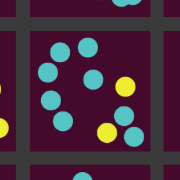Public Goods Games - Simulation
This multi-agent model investigates the dynamics of group-structured populations, where some group member (the "altruists") pay in a common pot, which is then divided among all group members. The model shows that this structuring into groups is sufficient for the evolution of populations consisting predominantly of altruists. Neither kinship nor competition between groups are necessary.The standard setup, as also given initially, usually leads to a stable population of mostly altruistic agents.
To run the simulation click SETUP and GO and then observe how the population develops. Click GO again to stop the simulation.

Further information about the model and details about the various parameters can be found further down the page in “Model Info.”
On small devices it may be better to open the model in a separate window.